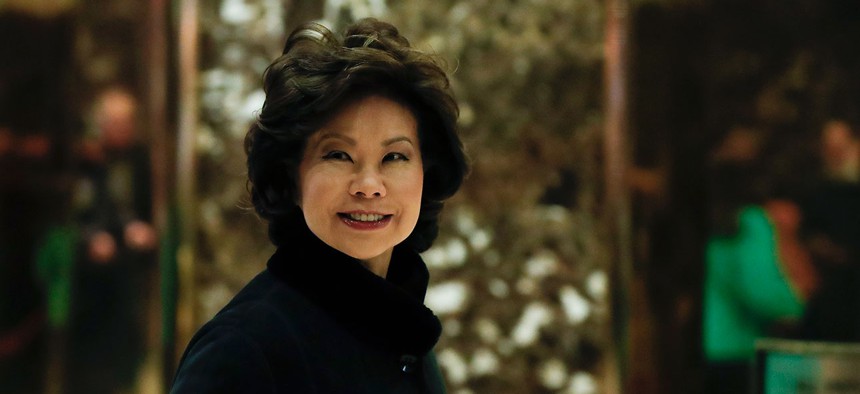
Carolyn Kaster/AP
Four Questions About the Incoming Secretary of Transportation
Former Labor Secretary Elaine Chao’s connections to Congress will likely prove useful.
Former Secretary of Labor Elaine Chao was announced as President-elect Donald Trump’s pick for Secretary of Transportation, as POLITICO first reported Tuesday. The New York Times ‘s Maggie Haberman tweeted that as of Monday night, Chao was seen as a “dark horse” candidate in a mix that included Lou Barletta, John Mica, Greg Hughes, and others—yet she has received applause for being a more “normal” choice than many of Trump’s other cabinet choices, which so far include Betsy DeVos, avowed enemy of public education, as Education Secretary, and Ben Carson, a former neurosurgeon with zero experience working in housing, leading HUD. What might Chao’s leadership mean for the future of transportation policy? A few key points about her record offer some hints.
Chao is a seasoned choice: She served a full eight years as Labor Secretary under President George W. Bush, and already had years of experience in top-level federal positions before that. Under the first President Bush, Chao served at the Department of Transportation as a maritime administrator and then as deputy secretary. She knows her way around the White House.
Chao is also the wife of Senate Majority Leader Mitch McConnell. That relationship could come in handy with what could be one of Chao’s major early duties as Transportation Secretary: shaping Trump’s much-touted infrastructure bill and getting it through Congress. (McConnell has already said this is not going to be a priority.) Some see the potential for conflicts-of-interest ahead. However, there is precedent here: Elizabeth Dole served as DOT secretary while she was married to the former Senate Majority leader Bob Dole (and later served as Labor Secretary—Chao is following her footsteps closely).
Could Chao be a bipartisan force?
Transportation has historically been seen as a (comparatively) bipartisan issue, and some presidents have chosen to appoint leaders from the opposite party to head DOT (see: the Democrat Norman Mineta under President Bush; the Republican Ray LaHood under President Obama). Trump did not make such a choice with Chao, a conservative who’s logged a lot of time at the right-leaning Heritage Foundation think tank. But Chao does represent a far less ideological voice, compared to several other members of Team Trump.
And she may relish the opportunity to work in less-divisive terrain. According to a 2001 Newsday article, Chao had mixed feelings about taking the cabinet post for the Department of Labor—which Chao later called “the most partisan of all the departments”—when President Bush initially asked her; she apparently had her “heart … set on leading the Department of Transportation.” Now she’ll get her shot.
Will Chao advocate for people or companies?
Chao has said that her experience as an immigrant, more than ideology, shaped her leadership at Labor. A month-long voyage on a freighter brought Chao and her family to the U.S. from Taiwan when she was eight years old. Chao spoke no English at the time, and yet “within a decade she was attending Mt. Holyoke College and later Harvard Business School,” the Washington Post reported in 2008. "I knew so little about mainstream America and what services were available," Chao said in that article. "I know what it is like to feel vulnerable and fearful during a difficult time. That's why I am always exhorting my colleagues that whatever we do, it has a real impact. We are not just dealing with programs or pieces of paper." During Chao’s tenure at the DOL, occupational fatalities, workplace injuries, and mining fatalities fell to record lows, and the department “helped workers win a record amount of back pay for minimum wage and overtime violations,” according to the New York Times.
But critics of Chao said safety statistics were more a result of the country’s shift away from more-dangerous manufacturing jobs, and that those back-pay victories merely reflected the desire of corporations to tamp down on private lawsuits. Under Chao, the DOL did not pass a single new rule on workplace hazards, outside of what courts mandated. The agency was also critiqued by the Government Accountability Office for shoddy enforcement of wage and hour laws, and by labor groups for its lax regulation of mine safety violations.
What might this record say about Chao’s prospects in her new job? The DOT is tasked with creating and enforcing safety standards for emerging transportation technologies, including autonomous vehicles and high-speed rail, as well as for existing roads (see: the DOT’s newly created pedestrian safety initiative). It’s worth watching whether Chao advocates more for drivers, riders, and pedestrians, or for the companies manufacturing cars and other mobility choices.
Will Chao support racial equity or the environment?
Equitable access to transportation and economic opportunity has been a major priority of the current transportation secretary, Anthony Foxx, who has often spoken about mending the racial and economic divides created by 20th-century highway building. Chao seems unlikely to share this interest. Prior to her appointment as labor secretary, she repeatedly expressed harsh opposition to affirmative action programs designed to increase diversity in schools and companies, calling out the “damage” created by setting special quotas or preferences of any kind.
Chao was also in the news in January 2015, after she quit the board of Bloomberg Philanthropies over the foundation’s plans to ramp up investments in its "Beyond Coal" initiative. Her service on the board was criticized as undermining Mitch McConnell’s commitment to keep Kentucky's struggling coal industry alive. (McConnell recently admitted that ending the “war on coal”might not exactly be in the cards). Chao’s resignation over coal does not a policy position make, but it is at least a cue to watch her transportation leadership whenever it intersects with climate, clean fuels, and electric vehicles—which could be often, given Trump’s rhetoric on rolling back auto emission standards.






